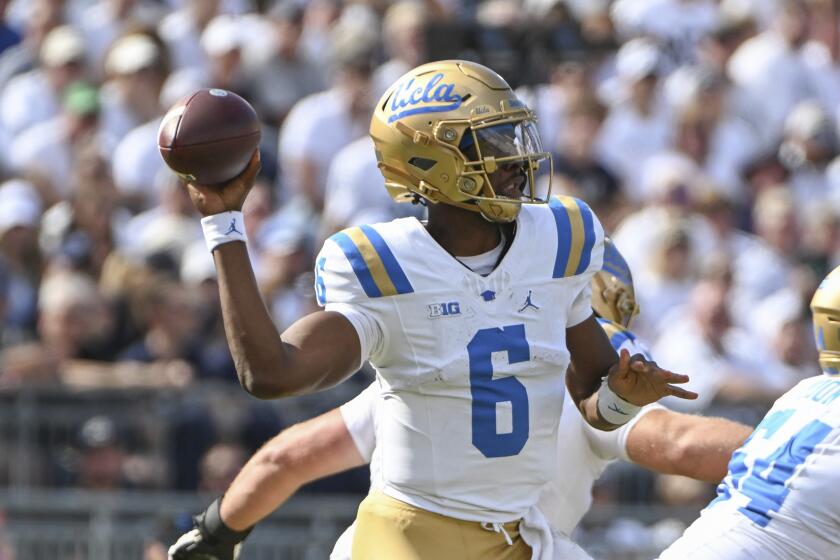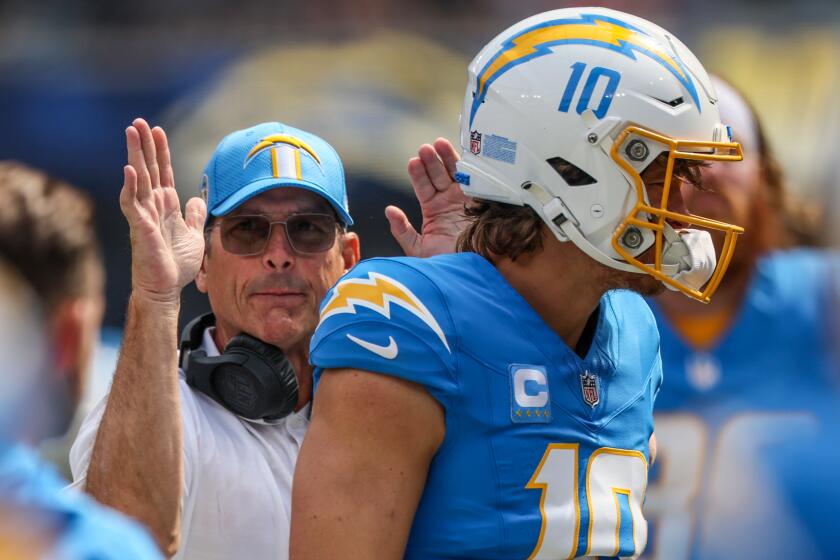Racetracks Go to the Whip
Lisa Sanders was drawn back into the horse-racing world of Seabiscuit when she read Laura Hillenbrand’s bestseller in her Modesto book group. She loved it so much she rushed out to see the movie.
Then she picked up the phone, called her daughter in San Diego and insisted they go to a track to see the real thing. “I’ve got to see the horses racing,” she recalls saying.
For the record:
12:00 a.m. Aug. 15, 2003 For The Record
Los Angeles Times Friday August 15, 2003 Home Edition Main News Part A Page 2 National Desk 1 inches; 42 words Type of Material: Correction
Seabiscuit -- A caption that ran with an article about the horse-racing industry in Sunday’s Business section incorrectly gave the impression that the racehorse Seabiscuit ran in the 1940 Santa Anita Derby. In fact, Seabiscuit ran in the 1940 Santa Anita Handicap.
For The Record
Los Angeles Times Sunday August 17, 2003 Home Edition Main News Part A Page 2 National Desk 1 inches; 44 words Type of Material: Correction
Seabiscuit -- A caption that ran with an article about the horse-racing industry in the Business section Aug. 10 incorrectly gave the impression that the racehorse Seabiscuit ran in the 1940 Santa Anita Derby. In fact, Seabiscuit ran in the 1940 Santa Anita Handicap.
Which is how Sanders came to be at Del Mar Friday afternoon.
The book and the movie “are the main reason I’m here,” said Sanders, 62, looking festive in a floppy pink hat and sunglasses.
Sanders had been to the races years before. The Seabiscuit craze brought her back. The horse racing industry is hoping that there are a lot more people like Sanders out there -- and that they won’t fade away when the Seabiscuit fad does.
When the legendary horse ruled the paddock in the 1930s, horse racing was a national passion. The end of Prohibition, a bevy of new tracks such as Santa Anita in Arcadia and a country aching for escape from the Depression made it truly the king of sports, “far and away America’s most heavily attended,” Hillenbrand wrote in her book.
Seven decades later, track owners are betting that another confluence of events -- notably the movie “Seabiscuit” and this spring’s widely followed bid by Funny Cide to win the Triple Crown -- will again give racing a badly needed lift.
The odds remain long. Live attendance and wagering are sliding at many racetracks nationwide. Operators are struggling to boost revenues and earnings.
There’s no mystery about what the industry needs: “to bring new people to our racetracks,” Jim McAlpine, chief executive of Santa Anita’s owner, Magna Entertainment Corp., told analysts this month.
Even if “Seabiscuit” does that, industry insiders and analysts don’t believe it will be enough.
“It’s not going to turn around overnight because ‘Seabiscuit’ provides a little boost to attendance,” said Ryan Worst, an analyst at investment firm C.L. King & Associates in New York. Horse racing “needs more ideas and more marketing to consistently stay in front of people -- so when people think of how they’re going to entertain themselves on a Saturday afternoon, horse racing comes to mind.”
A Lot of Betting Choices
Indeed, consumers today have myriad betting and entertainment choices compared with the 1930s, when horses provided one of the few avenues for wagering. Racetracks these days compete with state lotteries, Las Vegas, Atlantic City and Native American casinos, not to mention all of the other sporting and leisure venues now available.
Simulcasting -- whereby horse bettors can wager on televised races held around the country -- and other off-track betting vehicles such as the Internet have helped offset the slump in live track attendance. But total wagering is still growing only in the low single digits.
U.S. race betting rose 3.5% last year to $15.1 billion, and it edged up 2.5% in this year’s second quarter, according to market research firm Equibase Co. Of the bets laid in 2002, $13 billion -- or 87% -- were made off-track. As for live, at-the-track wagering, it fell last year to $2 billion, down from $2.1 billion in 2001 and $2.9 billion in 1996.
The 320-acre Santa Anita complex -- where a life-size bronze of Seabiscuit, who raced there 11 times, stands in the walking ring -- is a showcase for the industry’s problems.
Average daily attendance totaled 8,842 at this year’s spring meet, the lowest since the track opened in 1934. (Santa Anita has racing in the fall at the Oak Tree meet.) The track’s “handle,” or total amount bet, slipped to $1.41 billion last year from $1.43 billion in 2001.
And in the first half of this year, Santa Anita’s on-track wagering “was down about 10%,” McAlpine told the analysts. Off-track betting filled much of the gap, but the track’s total handle still dropped about 2.5% from a year earlier, he said.
The track’s owner, Magna Entertainment, is 59% controlled by Magna International Inc., a major Canadian auto-parts supplier headed by Frank Stronach, an avid racing enthusiast and thoroughbred owner. Magna Entertainment, which also owns several other tracks such as Bay Meadows near San Francisco, lost $14.4 million last year on revenue of $549.2 million.
The company this month posted sharply lower second-quarter profit and its stock has been sliding for several months; after reaching $7 a share last November, it closed Friday at $4.04 a share, up 24 cents, on Nasdaq.
But Stronach reportedly is looking at adding to Magna Entertainment’s stable with a possible bid for Belmont Park, home of the final leg of the Triple Crown, and two other New York tracks, Saratoga and Aqueduct. Stronach is eyeing an offer for the license held by the New York Racing Assn., which runs the tracks, Associated Press reported last week. That license might become available in 2005, if not sooner.
Magna and other track owners have tried several tactics to boost live attendance. They’ve spruced up their facilities -- Santa Anita had a $45-million face-lift in 1999 -- and consolidated big-stakes races into a single blockbuster day. Hollywood Park, for instance, has Friday night races and its owner, Kentucky Derby host Churchill Downs Inc., installed “novice” windows for neophyte bettors.
Five years ago, the sport organized the National Thoroughbred Racing Assn. to promote racing. It has had some success, such as gaining wider TV exposure for the sport, but it has been unable to stop the slide in live attendance.
Casino-Type Add-Ons
Some tracks are considering allowing slot machines and other casino-type gambling on their sites, but getting state permits has been slow. Santa Anita and others also are looking at ways to “monetize” their tracks’ massive real-estate holdings by developing entertainment complexes with offerings far beyond racing that might garner bigger crowds.
Could “Seabiscuit” make a difference? Industry observers said they couldn’t yet point to much evidence that they’re reaping anything from the movie, released two weeks ago, or from the widely followed effort by Funny Cide to win the Triple Crown.
There have, however, been a few promising signs:
* The movie drew generally good reviews; its attendant publicity before and after the film’s release led to widespread media coverage about horse racing.
* Two days before the movie came out, the racing meet at Del Mar began with a crowd of 40,682, the largest opening day in its 66-year history.
* When Funny Cide tried but failed to win the Triple Crown at the Belmont Stakes in New York, the event not only drew the highest ratings for a horse race since 1990, it was the top-rated show of any network program in the first week of June.
* In late October, Santa Anita will play host to the final races for the widely followed Breeders’ Cup championships, and corporate sponsorships for the event have been growing with the likes of Nextel Communications Inc. and DaimlerChrysler’s Dodge division signing on.
The Breeders’ Cup also could be the first big test of whether “Seabiscuit” helps lure casual fans to the racetrack.
Still, while big events such as the Breeders’ Cup and the Belmont Stakes draw big crowds, the struggle is getting people to come back on other days -- or at least to place more off-site bets on those days.
At the same time, many agree that for off-track betting to keep growing, the sport first must persuade more newcomers to attend the track to learn about racing and wagering. Also, it’s more profitable for a track to have more live fans than off-site bettors, because the track keeps a greater share of the dollars wagered and reaps the benefits of admission and concession sales.
“We know that if someone learns to enjoy racing by going to a track, that person is a great prospect for wagering from home” via TV, telephone or the Internet, said National Thoroughbred Racing Assn. Commissioner Tim Smith.
Trouble is, many observers say that potential new customers are baffled by horse-racing wagering, and that the sport must do more to teach them in a friendly environment at the tracks.
“It’s more difficult to bet on a horse than it is to pull a lever on a slot machine or buy a lottery ticket,” said Worst of C.L. King. “I don’t think the industry really has a program in place that makes it easy for new fans to become wagerers.”
‘Thinking Man’s Wager’
Smith agreed that “it’s intimidating to some people in this age of instant gratification.” He said racing should “market the challenge and fascination of handicapping” races.
“Those of us that enjoy it view it as the thinking man’s wager,” he said, “and a lot more exciting than pulling a handle on a machine.”
As they cast about for ways to draw bigger crowds, tracks are studying ways to wring profits from their facilities and parking lots, which cover hundreds of acres yet sit empty for months when racing is elsewhere.
Magna Entertainment’s McAlpine said racing could follow Las Vegas’ example. “They added entertainment and shopping to the basic gambling experience, and we think you can replicate that at the racetrack,” he told the analysts.
The company is mulling over ideas for adding retail or entertainment projects on about 80 acres at Santa Anita, but nothing definite has been decided, according to Magna Entertainment’s government filings.
That could soon change. Magna International recently announced plans to spin off its real estate operations, and its 59% stake in Magna Entertainment, into a publicly held company.
The new company, to be called MI Developments Inc., might accelerate real estate projects around Magna Entertainment’s tracks, including Santa Anita.
Back at Del Mar on Friday, racing aficionado Michael Lane sat at a table on the second-floor patio, hunched over the Daily Racing Form and the Del Mar program and furiously circling horses’ names and statistics with a pencil.
The 56-year-old from Simi Valley, sporting a Hawaiian shirt and visor and smoking a cigar, said he went to various Southern California tracks 15 to 20 times a year.
He’s not there because of “Seabiscuit,” he said, but for “the intellectual challenge” of picking the right horse.
He agrees that horse racing needs to attract casual fans too. “What they need to do is market racing better,” he said. “They need to appeal to everybody,” not just the avid bettor.
To that end, Del Mar has begun to offer free daily seminars for new bettors and rock concerts after the last race on Friday nights -- which appears to be working, given the large number of younger people in the crowd.
Track spokesman Mac McBride said that attendance in the first two weeks of the meet this year was up about 13% from a year ago, which he attributed mostly to the “Seabiscuit” phenomenon.
“We are riding that wave right now,” he said. “What we’re hoping for is to make long-term fans here.”
More to Read
Go beyond the scoreboard
Get the latest on L.A.'s teams in the daily Sports Report newsletter.
You may occasionally receive promotional content from the Los Angeles Times.











